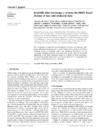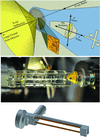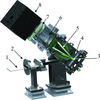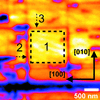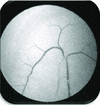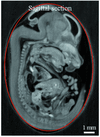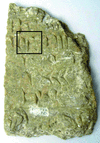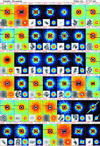issue contents
November 2014 issue

Cover illustration: Top: schematic of a high-temperature polymer electrolyte membrane fuel cell (see Eberhardt, Marone, Stampanoni, Buchi and Schmidt, pages 1319-1326). The membrane electrode assembly features at either side a gas diffusion layer (GDL), a microporous layer (MPL) and a catalytic layer (CL). Patches of phosphoric acid (PA) in GDL and MPL are shown in yellow. Bottom: slices of GDL (left) and MPL (right) which are imaged using X-ray phase contrast at 20 keV. For the GDL, PA-filled regions are white, carbon fibres and carbonaceous binder grey. For the MPL, yellow arrows indicate PA-filled cracks and voids.
facility information
research papers
Measurement results of a new X-ray beam position monitor based on a super-thin single-crystal CVD diamond are presented. The device, characterized at a synchrotron low-energy beamline (4 keV), demonstrates low X-ray absorption (<3%), time-stable operation, relative homogeneous response, and beam position and intensity monitoring with submicrometer resolution and 2 permil precision, respectively.
Data Exchange, a simple data model designed to interface, or `exchange', data among different instruments and to enable sharing of data analysis tools, is presented. Its successful application to a variety of X-ray techniques, including tomography, fluorescence spectroscopy, fluorescence tomography and photon correlation spectroscopy, is described.
Open  access
access
 access
accessStrategies are described for optimizing the signal-to-noise of diffraction data, and for combining data from multiple crystals. One challenge that must be overcome is the non-random orientation of crystals with respect to one another and with respect to the surface that supports them.
Open  access
access
 access
accessA new detector for sub-millisecond EXAFS spectroscopy at the European Synchrotron Radiation Facility
The design and performance of the new sub-millisecond detector for time-resolved X-ray absorption spectroscopy at ID24 at the ESRF is described.
Open  access
access
 access
accessThe diffraction anomalous fine structure method has been revisited by applying this measurement technique to polycrystalline samples and using an analytical method with the logarithmic dispersion relation.
The novel capabilities of a newly designed full-field X-ray reflection microscope to image a thin film with 70 nm resolution and sub-second exposures are demonstrated.
A newly developed high-throughput X-ray diffraction and fluorescence experiment is capable of measuring more than 5000 samples per day, meeting the structural characterization needs for high-throughput material genomic searches.
A method simplifying EXAFS analysis of highly disordered materials is presented.
Embedding Tc oxides in epoxy allows measurement of the Tc L-edge spectra under UHV conditions. Changes in the Tc L-edge XANES spectra provide information on the oxidation state, crystal field splitting and coordination environment.
Characteristic features of the in-vacuum undulator of the 8C nanoprobe/XAFS beamlime (BL8C) at Pohang Light Source, operated in planar, tapered and gap-scanning modes, are presented.
X-ray speckle visibility spectroscopy combined with photon statistics analysis is developed to probe the structural dynamics in materials. This method is benchmarked against X-ray photon correlation spectroscopy by studying diluted silica particle suspensions.
Short-range order has been investigated in Zr69.5Cu12Ni11Al7.5 and Zr41.5Ti41.5Ni17 metallic glasses using X-ray absorption spectroscopy and ab initio molecular dynamics simulations.
Radiation dose dependency of image quality was showed in in vivo rabbit lung images with and without a contrast agent using the synchrotron-radiation-based K-edge subtraction method. Consistency of the theoretical and measured radiation dose rate values was found.
The rat suture middle cerebral artery occlusion (MCAO) is a frequently used animal model for investigating the mechanisms of ischemic brain injury. During suture MCAO, transection of the external carotid artery (ECA) potentially restrains blood flow and impairs masticatory muscle and other ECA-supported territories, consequently influencing post-operation animal survival. This study investigates the effect of ECA transection on the hemodynamic alterations using a novel synchrotron radiation angiography technique and magnetic resonance imaging.
The methodology for applying propagation-based phase contrast imaging on high-temperature polymer electrolyte fuel cells for quantification of phosphoric acid in the different fuel cell components is described.
The fundamental performance of microangiography has been evaluated using the S-band linac-based inverse-Compton scattering X-ray (iCSX) method to determine how many photons would be required to apply iCSX to human microangiography.
A fast algorithm for ring artefact reduction in high resolution micro-tomography with synchrotron radiation is presented.
Open  access
access
 access
accessQuantitative measurements of biological fresh samples based on three-dimensional densitometry using X-ray phase contrast tomography are presented.
The modulation of measured X-ray fluorescence by surface topography is analyzed. A correction procedure allows trace element analysis of samples having a uniform matrix using only fluorescence data from a single detector. This procedure is used to generate element maps and the surface topography of an incised gypsum tablet.
short communications
Open  access
access
 access
accessA novel method for time-resolved study of chemical kinetics using a windowless mixing jet at an X-ray free-electron laser (XFEL) is described and demonstrated. The short mixing time gives a time resolution of about 250 µs; the design introduces controllable delays after the initiation of a chemical reaction, allowing the possibility for detection of transient structures by an XFEL beam pulse. Applications may include time-resolved enzyme–substrate imaging or protein folding.
A high-precision instrument suitable for mapping rotational errors in rotary stages has been developed. By performing comprehensive characterization of rotational errors, the performance of tomography systems can be drastically improved.
beamlines
Beamline 2.1, a transmission soft X-ray microscope at the Advanced Light Source of Lawrence Berkeley National Laboratory, is described.
computer programs
To control a diffractometer and to perform data processing, two software suites with user-friendly graphical user interfaces have been developed to efficiently perform cryogenic coherent X-ray diffraction imaging experiments on non-crystalline particles using an X-ray free-electron laser.
current events
Free 



 journal menu
journal menu


















